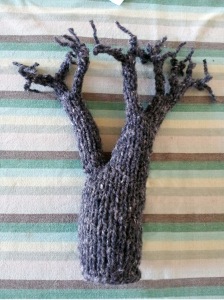Last week I got chatting to Étienne Ghys, a wonderful French mathematician who was in Edinburgh showing us his new films about Chaos. We told him about Botanica Mathematica and he said “You could knit a Fibonacci tree!”.
And I thought, “Why haven’t we already knitted a Fibonacci tree??” The idea was so obvious and its execution so easy that it seemed silly not to have done so already. The Fibonacci pattern is also an excellent model for how plants actually grow, so it was perfect for the Botanica Mathematica project.
How does the Fibonacci model work? Well, you start with a branch, and after a certain period of time it splits into two smaller branches: a main one and a sapling. In the next time period the sapling stays the same size as it grows to adulthood, while the main branch once again splits into two. (We had a discussion of this in a previous post.) Here’s a picture of the resulting tree:
 The black numbers to the right indicate how many branches there are at each time step. This sequence of numbers is known as the Fibonacci sequence, and the next number is the sum of the previous two.
The black numbers to the right indicate how many branches there are at each time step. This sequence of numbers is known as the Fibonacci sequence, and the next number is the sum of the previous two.
The small blue numbers next to each branch indicate how wide the branch is – in knitting terms this is the number of stitches you are knitting with (in the round) for that branch.
So, start at the bottom of the tree by casting on 21 stitches. Join in the round and knit for 21 rows (the blue numbers also indicate the height of each branch!). Then put 8 of the stitches onto a stitch holder while you knit with the other 13 (joined in the round). After 13 rows, put 5 stitches onto a stitch holder while you knit (in the round) with the other 8, continuing in this way until you reach the top of the tree. Then go back to the last set of stitches being held, pick up the stitches and knit in the same way as before to the top of the tree. (It’s exactly the same technique as for the binary bonsai.)
There’s Fibonacci numbers everywhere in this tree: in the number of rows you do at each stage; in the size of each branch; and in the number of branches at each horizontal cross-section. The ratio of successive Fibonacci numbers gives (an approximation to) the golden ratio, and indeed the finished tree has a pleasing dimension and appearance to it. I think it looks more realistic than the binary bonsais.
Here’s a picture of my finished tree:
 Do you like it? Do you have more ideas of what we could make, or ideas of how to adapt the Fibonacci tree? Let us know!
Do you like it? Do you have more ideas of what we could make, or ideas of how to adapt the Fibonacci tree? Let us know!
